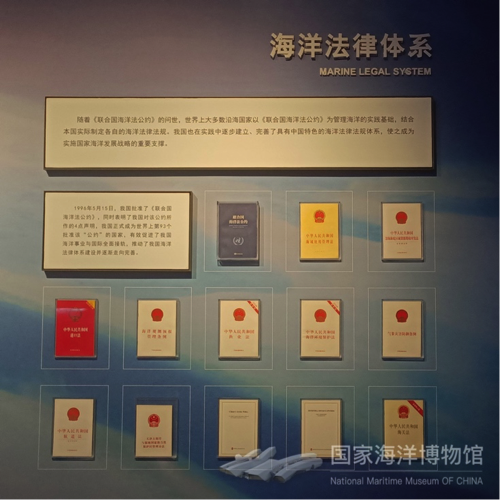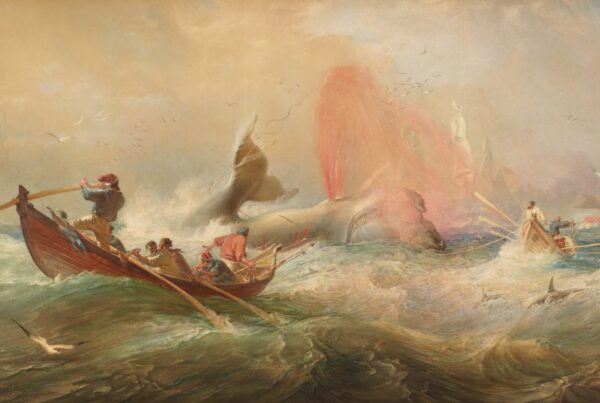China’s Science and Technology for the “Deep-Sea”
In China’s Deep-sea Exploratorium,[1] hydrothermal vents are described as ‘the ocean beneath the seafloor’ (Figure 1). Seawater percolates down along faults and fissures on the ocean floor, coming into contact with hot lava at depths of 4,000–5,000 metres below the seafloor. As a result, hydrothermal vents or submarine volcanic eruption could form from the energy the sea has swallowed. Existing in the depths and darkness of the ocean floor, the invisibility of hydrothermal vents protects them from the ripple effects of the Anthropocene on global ecology. In fact, the energy emitted by hydrothermal vents is thought to create a ‘dark biosphere’ that is distinct from the sunlight-dependent biosphere on land or in shallow seas. The chemical energy-synthesizing bacteria of deep-sea hydrothermal vents provide the basis for hydrothermal organisms that can spread to depths of more than a thousand metres and may be tens of millions of years old. The vast hydrothermal flora and the deep-sea ecosystems they support challenge established taxonomies and may more intuitively shift an anthropocentric perspective towards a ‘derangement of scale’ (Timothy Clark, 2012).
On issues about climate change, Timothy Clarke argues we might need to confront the exigency of thinking “everything at once.” This brings with it “the overall force of an implosion of scales, implicating seemingly trivial or small actions with enormous stakes while intellectual boundaries and lines of demarcation fold in upon each other” (Clarke 2012, p. 152). The incredible vitality and life-scale of hydrothermal flora makes us question whether we can fully see or speculate the potential influences of humans’ scientific explorations regarding the vast temporality of the deep ocean that should exist outside the Anthropocene. In other words, thinking and imagining the ‘ocean beneath the seafloor’ as a more-than-human utopia may facilitate ways to connect with the ocean that are contrary to the Anthropocene and discourses of human extractivism. At stake is, ‘the profound tensions emerging between the apparent urgency of planetary time in the face of [potential] ecological disaster and the foot-draggingly slow time of business as usual in the dominant political and economic regimes’ (Clarke, 2019, p. 137).
At this point, the narrative created by scientific exploration of hydrothermal fluids may be creating a crisis on a timescale that remains unknown. In China, scientific research has targeted deep-sea hydrothermal fluids as a much-needed object of exploration and a potential source of energy and minerals. This narrative has a lot to do with current Chinese nationalist discourses, ambitions in international relations, and its continued projection of aqua-politics throughout the world oceans. For example, China is currently in competition with the United States to explore hydrothermal vents in the South Pacific and the Indian Ocean, with the ultimate goal of claiming resources found in those areas. Within this context, energy competition can be viewed as both a symbol of agency within international politics and as the exterior for extraction within the deep-sea realm. As Elspeth Probyn argues:
Out of sight, currently there is a race of ocean-grabbing to mine the bottom of the sea. Couched in concern for the environment, companies are eager to exploit the mineral resources for the defossilisation of the economy which will rely on batteries, and the minerals and metals they require – copper, cobalt, nickel, and manganese. The deep ocean has these in abundance, much more than the whole of the terrestrial earth. (2023, p.2)
In a paper entitled “Progress and Prospect in China in Research to Submarine Hydrothermal Activities,” author Zeng Zhi-gang suggests that:
Mineral resources are an important material basis for the national economy, an important strategic resource for national modernisation and social development, and a fundamental component of the comprehensive national power of sovereign states … seafloor hydrothermal activity is not only one of the entry points for deep-sea research. The polymetallic sulphide accumulation formed by it is rich in useful elements such as copper, zinc, gold and silver which are both indispensable for the development of industries such as smartphones and electric cars, and an important strategic key mineral resource of the seabed. (2021, p.1333)
The narrative describing hydrothermal vents as a common resource reservoir or deposit for humanity is consistent with the legal framework developed by the United Nations Convention on the Law of the Sea. Guided by an extractive imaginary, UNCLOS institutionalised a discursive, abstract version of the ocean, cutting it up into functional zones open to extractive industries. Through this framework, UNCLOS has created an outwardly expanding, competing, agency-free model of the ocean in which all but a few substances of commercial or political value have been set aside. Significantly, China has branded its own maritime affairs as UNLOS-compliant in any public forum. In the National Maritime Museum[2] in Tianjin, China, Chinese maritime law documents are publicly exhibited alongside UNCLOS law, implying that they share a consistent legal genealogy (see Figure 2). This is largely used as evidence that China is developing an ‘image as a responsible power’ in international maritime affairs. Although Elisabeth Mann Borgese, one of the co-authors of UNCLOS, long pointed out that the concept of ‘freedom of the seas’ that dominates UNCLOS has often turned into ‘the stronger to ride roughshod over the rights of the weaker’ (Borgese, 1975, 228).
Let us return for a moment to Zeng’s (2021) argument where he correlates China’s ‘modernisation’, ‘smartphone, electric car, and other industries’ with deep-sea hydrothermal vents. Here the “derangement of scale” becomes particularly glaring. According to the New York Times on 27th September 2022, Chinese President Xi Jinping declared in 2014 that the development of electric-powered vehicles “is the way for China to move from being a big auto power to a strong auto power.” By 2022, China was already one of the world’s largest and fastest-growing electric vehicle markets, with sales of new energy vehicles doubled to around six million, more than the rest of the world combined. In this narrative, new energy vehicles illustrate China’s efforts towards global environmental issues on a single indicator of carbon emissions. In an unnoticed deep-sea dimension, however, it depends on extractivism. In other Chinese scholarly discourses, the exploration of hydrothermal vents reveals hydrothermal activity throughout ocean evolution for the study of paleomass cycling and paleoenvironmental reconstruction (Sun et al, 2016). What is the link? This could allow us to consider another aspect of temporality – to understand what changes may occur in the future, we need to gauge the potential extent of marine diversity that is being lost today.
In considering the vanishing energy of the deep sea, Susan Reid reminds us that,
As the deep seabed mining frontier looms, it is important to also consider how the removal of seabed features such as mineral-rich hydrothermal vents will not only transform the seafloor topography but also diminish their soundscape…hydrothermal vents may also be vital to as wayfinding elements for marine animals navigating the seafloor. (2023, p.17)
There is certainly more than one form of energy. As I mentioned at the beginning, hydrothermal vents may well sustain an entire dark ecosystem with their unfathomable thermal energy. In this sense, hydrothermal vents are the ‘sun’ that lies beneath the sea. However, the closure of each hydrothermal vent would also mean the termination of an entire biome. Deep-sea networks created by energy connect more-than-humans together in ways beyond imagination. At the very least, we need an alternative narrative where humanity can see how it relates to the more-than-humans under the deep sea, rather than seeing the latter as raw material for technical industries and fuel for international competition.
References
Clarke, T., 2012. Derangements of scale. Telemorphosis theory in the era of climate change, 1, 148–166.
Mann Borgese, Elisabeth. 1975. The Drama of the Ocean. NY: Harry N Abrams Inc.
Probyn, E. (2023). Aqua/geopolitical conjuncture and disjuncture: invasion, resources, and mining the deep dark sea. Cultural Studies (London, England), ahead-of-print(ahead-of-print), 1–22. https://doi.org/10.1080/09502386.2023.2173793
Reid. (Forthcoming in 2023). Stirring and Deranging: Oceanic Energy Relations and Extractivism. reference
Sun Z L, Cao H, Zou M L et al, 2016. Remnants of a powerful ancient “Dynasty”: material cycle and biomineralization in modern seafloor hydrothermal system. Acta Geologica Sinica (English Edition), 90(6): 2287-2288 DOI:10.1111/1755-6724.13049
Zeng, Z-G. (2021). Progress and Prospect in China in Research to Submarine Hydrothermal Activities. Oceanologia et Limnologia Sinica, 52(6): 1333-1349. http://dx.doi.org/10.11693/hyhz20210400097
Notes
[1] It is the only museum in China dedicated to the deep seas and is located on the campus of Tongji University in Shanghai. The venue aims to educate the public about the biology, science and culture associated with the deep sea, providing a Chinese perspective on the narrative of the deep sea.
[2] The National Maritime Museum, jointly built and managed by the Chinese Ministry of Natural Resources and the Tianjin Municipal People’s Government, is the only national comprehensive maritime museum in China that integrates functions of collection, display, research and pedagogy. It provides a state narrative of China’s relationship towards the oceans.

Figure 1. Photograph of hydrothermal vents video footage at China’s Deep-Sea Exploratorium.
Photograph courtesy of the author

Figure 2. Chinese Marine Legal System (with UNCLOS first in line).


